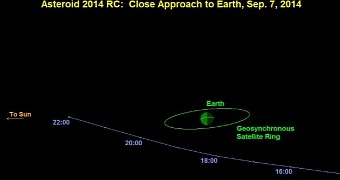This coming Sunday, September 7, our planet is to receive a visitor from outer space. No need to get ready for an “Independence Day” kind of scenario, as this visitor is merely an asteroid about the size of a house.
Space exploration enthusiasts with NASA say that the space rock, which goes by the name of 2014 RC, will make its closest approach at around 2:18 p.m. EDT (11:18 a.m. PDT / 18:18 UTC).
At that time, the asteroid will fly over New Zealand, at a distance of about 25,000 miles (approximately 40,000 kilometers) from our planet's surface, NASA specialists go on to explain.
Due to the fact that this space rock is by no means impressive size-wise, regular folks will not be able to see it buzz by our planet. Those who own small telescopes might catch a glimpse of it, but only if they strain their eyes.
Information shared with the public says that this asteroid was first documented by researchers with the Catalina Sky Survey near Tucson, Arizona only a few days ago, on August 31.
Based on how much light is reflected off its surface, scientists were able to determine its size. Thus, 2014 RC is estimated to measure approximately 60 feet (20 meters) in size. Hence, it is classified as a small asteroid.
Scientists who have taken the time to study its orbit say that, although the space rock will pass very close to our planet and to satellites orbiting some 22,000 miles (36,000 kilometers) above Earth, a collision is out of the question.
Specialists with NASA plan to study the asteroid's journey in detail, and expect that data obtained during this high-tech stalking session will help them better understand what space rocks like 2014 RC are all about.
“While this celestial object does not appear to pose any threat to Earth or satellites, its close approach creates a unique opportunity for researchers to observe and learn more about asteroids,” NASA writes on its website.
Interestingly enough, this space rock is expected to one day pay us yet another visit. Scientists say that, even if it does approach our planet again in the not-too-distant future, chances that 2014 RC will come to collide with Earth are pretty much slim to none.
“While 2014 RC will not impact Earth, its orbit will bring it back to our planet's neighborhood in the future. The asteroid's future motion will be closely monitored, but no future threatening Earth encounters have been identified,” NASA says.

 14 DAY TRIAL //
14 DAY TRIAL //